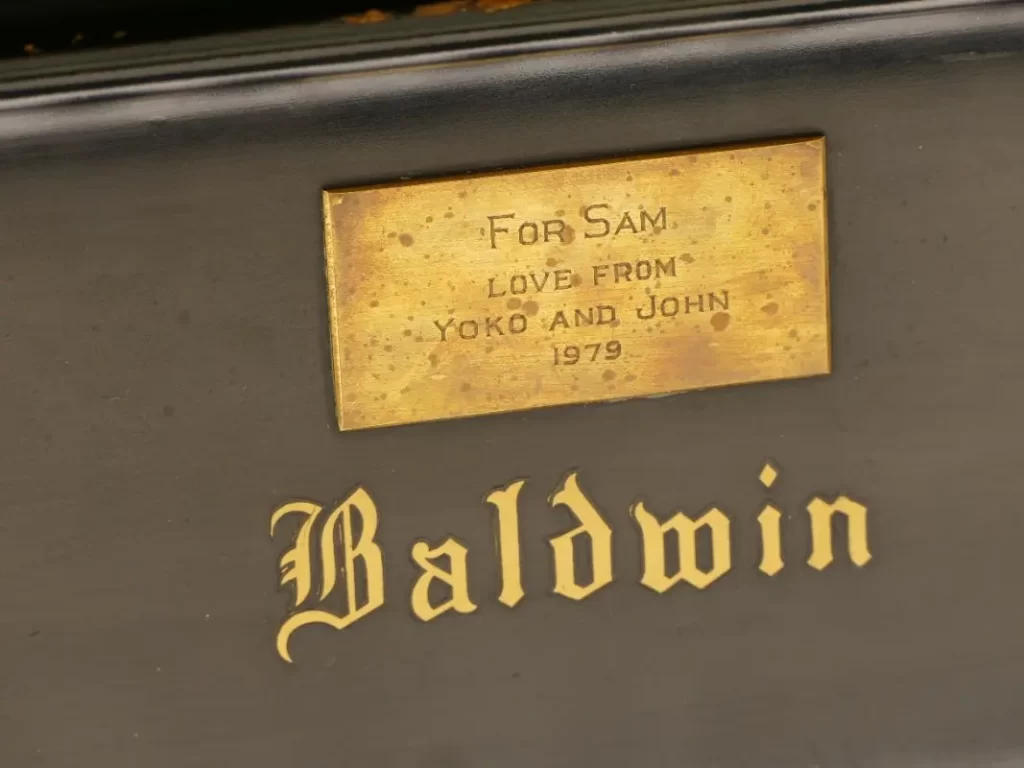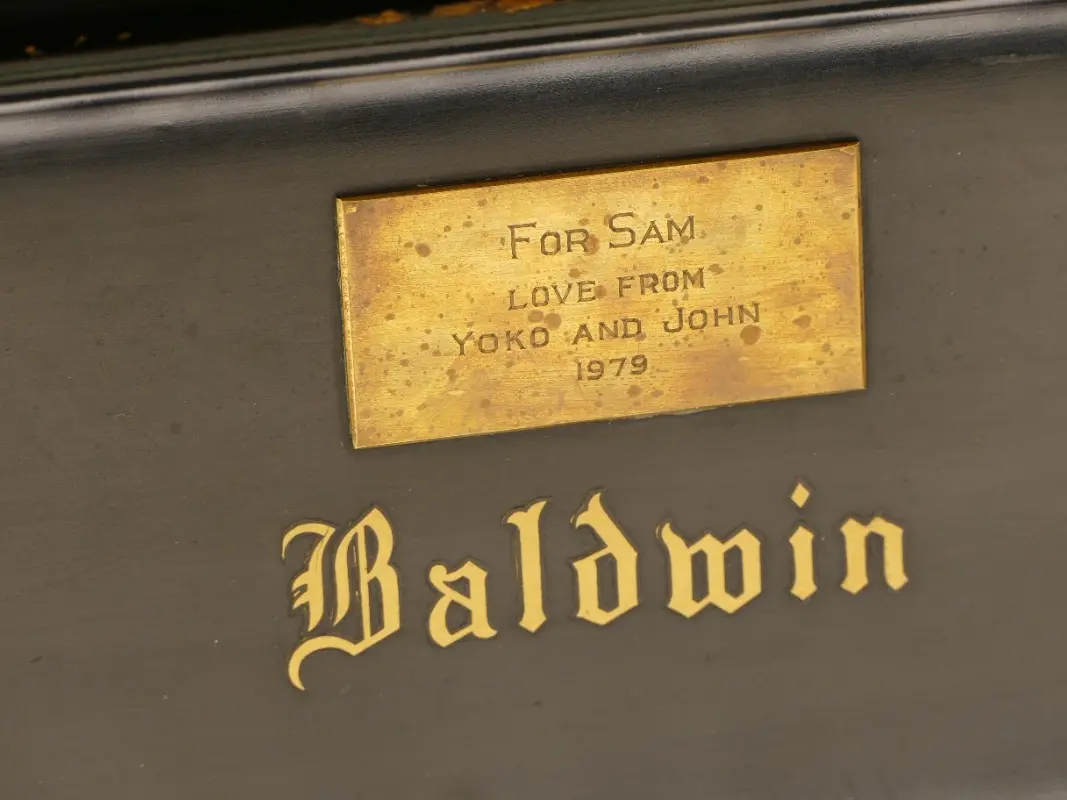by Maggie Fusek. Courtesy of Patch
WALNUT CREEK, CA — A piano owned by John Lennon and Yoko Ono in the late 1970s and linked to Andy Warhol in the 1980s is expected to fetch at least $3 million at an upcoming auction now that a Walnut Creek-based partnership has confirmed its authenticity.
“In the case of this piano, it is the history of ownership and the events and interactions between people that give it value,” Karen Lile, of Piano Finders, told Patch in an interview Thursday. “And you want to be able to trace it because you want to make sure there is no fraud.”
Lile spent three months in the spring of 2022 researching the provenance — a genealogy of origins — of the so-called “Lost Lennon-Ono-Green-Warhol Piano.”
Her Piano Finders partner, Kendall Ross Bean, performed the inspection of the piano.
Until August, the pair remained under a non-disclosure agreement — NDA — while further research was conducted and the piano’s current owner, Mercersburg Academy in Mercersburg Pennsylvania, decided how it would sell the piano and ensure the proceeds were used to launch a scholarship fund at the private school.
Once the NDA was lifted, Lile, like any good detective, was excited that her findings could finally be shared with the world.
In Lile’s opinion, the piano has one of the most interesting provenances on record because of its celebrity-on-celebrity value spanning music, art and celebrity social circles at a pivotal time in cultural history.
In short, once Bean confirmed the piano was a Baldwin built in 1929, Lile contacted Baldwin for confirmation that Lennon owned the piano. There was a letter documenting the purchase by Lennon in November 1978 as a used instrument from a Baldwin retail shop at 58th and 7th Avenue in New York City, but no record of previous owners.
It might be possible to trace the ownership between 1929 and 1978, Lile said, but a judgment call was made to focus on the provenance after it first acquired its known celebrity value when Lennon purchased it.

“For Sam, Love From Yoko And John, 1979”
Lennon and Ono gave the piano as a gift to their close friend, Samuel Adams Green, an art curator and the former director of the Institute of Contemporary Art at the University of Pennsylvania. Green had professional and personal relationships with both Lennon and Ono.
When the couple gifted the 9-foot satin ebony piano to Green, they had “For Sam, Love From Yoko and John, 1979” engraved on a bronze plaque and installed above the piano keys.
It was given in private and without newspaper coverage, Lile wrote, during the time Lennon was emerging from private life with Ono while raising their son, Sean Lennon. This was during a time when Lennon’s Beatles fan base was also getting older and starting their own families, something they saw reflected in Lennon and his growing family.
It might have remained just that, a private gift, were it not for the events that followed.
The piano’s journey continued to a cottage on Fire Island, New York. Lennon and Ono were frequent visitors to the island where Green owned several beach cottages. According to Green, Yoko thought the creative atmosphere on the island would help inspire John’s songwriting for their new album, later titled “Double Fantasy.”
Lennon’s will — created and signed in 1979, the year prior to Lennon’s Dec. 8, 1980 death — served as additional proof of the nature of the close relationship between Lennon, Ono and Green. In the will, Lennon appointed Green to act in Ono’s place in the event she died before Lennon or if for any reason she chose not to serve as the guardian of Lennon’s personal property and any children of the marriage.
During her research, Lile also found numerous records showing the close relationship between renowned pop artist Andy Warhol, Green, Ono and Lennon. Not only was Warhol a part of Green’s intimate circle of Fire Island Friends, but Green was also reported to have lent the Lennon piano from 1983 to 1986 to Warhol’s Interview Magazine office in Warhol’s “Factory” building on Madison Avenue and 33rd Street in New York City.
Warhol mentioned in his diary, “Sam Green was in everybody’s life, such a big part — he’s had Yoko Ono and John Lennon and Cecil Beaton and Greta Garbo and me.”
Lile pointed out that the piano was at Warhol’s building during the time period Warhol was experiencing with abstraction; his Rorshachs in 1984, and his Camoflages in 1986. Nine months before his death, Warhol created an iconic series of self-portraits.
The provenance recalls Warhol’s death on Feb. 23, 1987. An announcement on page 1 of the New York Times called Warhol a “founder of pop art whose paintings and prints of presidents, movie stars, soup cans and other icons of America made him one of the most famous artists in the world.”
Lost Lennon Piano Compared To A Picasso Or Stradivarius Violin
A not-so-good twist of fate happened after Green lent the piano to the New York Academy of Art in 1987. He was on the board of directors of the school and was unaware it would later be sold without his consent, which sparked the controversy surrounding the “Lost Lennon Piano.”
In a letter to the Academy dated June 4, 1999, Green wrote: “Actually, no one but John (Lennon) and I knew how valuable and unique this piano was. It could be compared to the Stradivarius Violin. .. It was the last of an advanced technology to be used in American pianos before the crash of 1929.”
At the time Green wrote the letter, he nor the New York Academy of Art knew where the piano was.
Who actually bought the piano from the New York Academy of Art would remain a secret for 22 years.
It turned out the piano was in use at the Academy from 1987 until almost 1999 when it ended up in the school’s basement where it was sold by someone at the academy to a wholesaler named Harold Katz. In an interview with Lile, Katz said he bought it and several other deaccessioned pianos for a bulk fee as part of a common industry practice to help the university by removing the pianos from the basement.
Katz bought the piano for $3,000 from Academy, then sold it with a lot of 10 pianos to a man named Buddy Bain in Alabama. Bain put the piano on display in the lobby of a bank and that is where it stayed until 2001 when it was found by members of the media.
Green’s legal pursuit of the piano was abandoned but there was a lingering mystery surrounding it.
“How would you feel if you had a Picasso in your possession and sold it for $300 without knowing what you had,” Katz said to Lile in an interview 22 years after he sold the piano to Bain.
In 2003, Bain sold the piano to Mansoor Emral Shaool and it became part of the family trust. In September 2018, the family donated it to Mercersburg Academy in Mercersburg, Pennsylvania, with a deed of trust that it be put toward a scholarship fund for students of the school.
In 2021, Alex Hernan, director of furniture at Alex Cooper Auctioneers in New York City, was contacted by the school and the donor to commission the piano’s provenance.
In 2022, Alex Hernan, director of furniture at Alex Cooper Auctioneers in New York City, was contacted by the school and the donor to find an appraiser who could also authenticate the piano’s provenance and inspect the piano. That is when Hernan contacted Piano Finders, and in April 2022, the pair traveled from Walnut Creek to Pennsylvania to begin their work.
Testament To An Era
“The Lennon-Ono-Green-Warhol Piano stands as a testament to an era that defined pop art and rock music, symbolizing the presence of iconic figures like Andy Warhol, John Lennon, and Yoko Ono,” Lile wrote in the official 268-page Provenance Report, excerpts of which are embedded in the document below.
Bids will start around $1 million for the legendary piano in a live auction at 10 a.m. Eastern Time, Saturday, Sept. 30, at Alex Cooper Auctioneers, 908 York Road, in Townson, Maryland.
Online bidding starts at 5 p.m. Eastern Time, on Friday, Sept. 15.
It marks the first time members of the public will have the chance to own this extraordinary piano, presenting a once-in-a-lifetime opportunity for avid collectors.
See an 18-page report on the provenance of the Lennon-Ono-Green-Warhol Piano:

